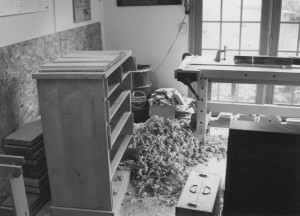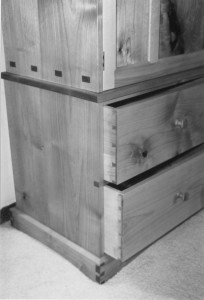“I can teach a man to sail but I can never teach him why”
Timothy Thatcher
This is the best part about handtools, using them to make something. From watching my woodpile get smaller to final fitting some dovetails, the use of handtools lets me enjoy each and every step along the way. But I have found that much of what I get from  handtools cannot be explained with words. I would liken it to describing a sunset; something is invariably lost in the translation. You simply have to be there, to do the work with your own hands and experience it for yourself.
handtools cannot be explained with words. I would liken it to describing a sunset; something is invariably lost in the translation. You simply have to be there, to do the work with your own hands and experience it for yourself.
Hands to Work
This part of the site is about putting the tools to work. It covers just about all the types of joinery I use and how I put a piece of furniture together.
There are no shortcuts in learning to use hand tools. It takes time and a lot of hard work. You could read every book ever written about them and might be no further ahead than the guy who just picked up the tools and tried them out. This isn’t to say that books and articles are of little use. Much of what I learned early on came from books and magazines.
But it reaches a point where you have to close the books and pick up the tools. Whether you are setting up a plane or cutting dovetails, using the tools to try something will teach you more than any written word. Even mistakes teach very valuable lessons.
 A lot of my writing wouldn’t exist if I had done only what was found in books. I had little to no direction or instruction for many of the methods I write about. At times all I had was a vague picture or idea and every thing branched out from that point. Maybe this is why apprenticeships at the turn of the century were so long. Experience is a teacher not easily dismissed.
A lot of my writing wouldn’t exist if I had done only what was found in books. I had little to no direction or instruction for many of the methods I write about. At times all I had was a vague picture or idea and every thing branched out from that point. Maybe this is why apprenticeships at the turn of the century were so long. Experience is a teacher not easily dismissed.
Making Boxes
There is a bit of a running joke that all furniture, even chairs in an odd sense, are just boxes. You start with a large box and fill it with smaller boxes (drawers) and flat boxes (doors). This says to me, when viewed from the right perspective, furniture is not that complicated to build. As long as you keep things simple and build a solid foundation of knowledge about carcase construction you can make just about anything.
When you make things by hand you provide the power as well as guides, limits, tolerances, stops, calibration, etc. Much of this is intuitive. In the doing you will learn how tight to make a joint or how smooth to plane a surface. Just how perfect things should be will be left up to you. And there are different levels of perfection….
It takes patience, dedication and commitment to make things by hand. And you have to love doing this, for sometimes there is no other reason to do it. And don’t forget, nothing happens fast.
One Last Thing
Even when you think you are done there is one more thing to do. Completion time is reflection time. A chance to look at what went right and what went wrong. (My Aunt once told me not to point out mistakes, sometimes you are the only one who can see them.) Take the time to look at your work and enjoy the results of your labor. Generally mistakes fade rapidly and are remembered only with effort, but the satisfaction of having done it all by hand lingers on.
“The end and reward of toil is rest”
James Beattie
